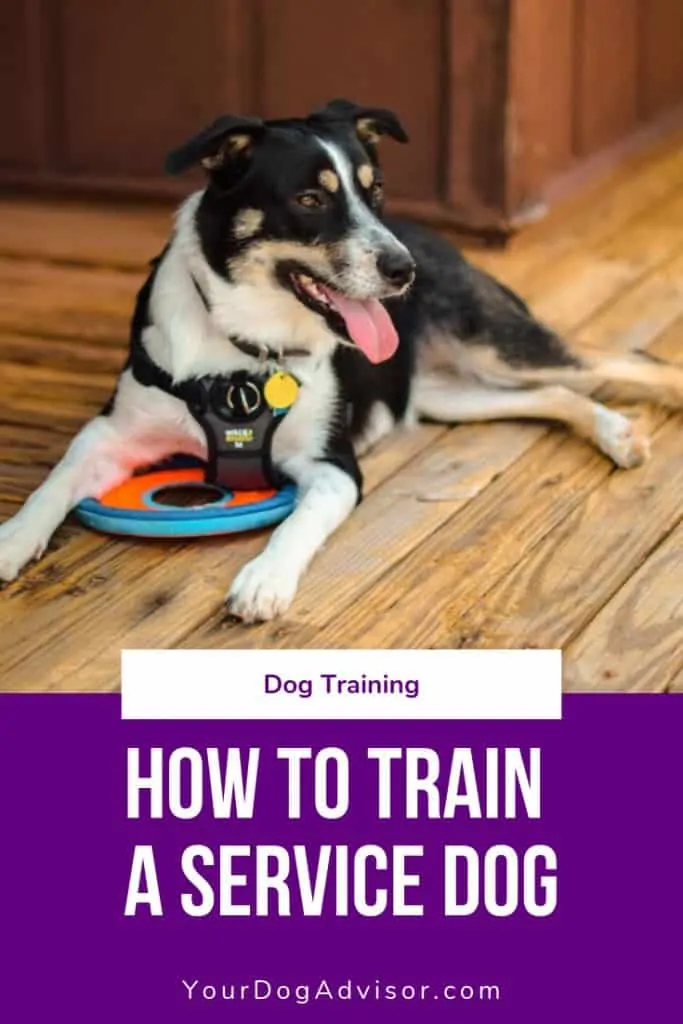Click here for full article, Images and videos

Every dog-lover knows the internal struggle of seeing a service dog with a “DO NOT PET” vest on. As hard as it is, it’s super important to know that service dogs aren’t defined as pets, but as workers. And for some people, they’re absolutely essential to everyday life.
According to the American with Disabilities Act (ADA), “service animals are defined as dogs that are individually trained to do work or perform tasks for people with disabilities.” They’re considered workers protected under federal law.
Training a service dog through a professional company ensures your canine will be at the highest level of training. However, with a dropout rate of 50-70%, long waiting lists, and racked up expenses, professional training is becoming less and less popular.
Instead, people are training their service dogs on their own. Owner dog training is usually a very rewarding experience and can help to create a stronger bond between dog and handler. Both are very important when it comes to having a pooch dedicated to maintaining your health. But it also means a lot of patience, time, and energy spent committed to training on your own, as well as working with a professional trainer for guidance.
Before we get into how to train a service dog, it’s important to note the differences between service dogs, emotional support dogs, and therapy dogs.
Types of Service Dogs
Service dogs usually fall into three types of categories: guide dog, hearing dog, and general service dog. While guide dogs assist those with eye-sight disability and hearing dogs assist those with hearing disabilities, service dogs offer a wide range of assistance from helping with wheelchairs and autism, detecting seizures, to alerting people their blood sugar is low. Service dogs are for one person only assistance.
Emotional support dogs offer comfort and support to anyone needing companionship through a mental or emotional illness. Both service dogs and emotional support dogs are legally allowed wherever their owner goes.
On the other hand, therapy dogs aren’t allowed just anywhere, but they do bring happiness and support to just about everyone. They’re for bringing cheer to hospitals, nursing homes, the homeless, and even students.
Eligibility
First and foremost, you need to make sure your type of dog is of eligible breed, temperament, health, and age.
At the moment, all types of breeds are suitable to be a service dog, however some are more preferable than others because of different breed instincts.
For instance, golden retrievers, labrador retrievers, german shepherds, and border collies are common service dog breeds because of their large size and trainability. They’re large enough for mobility purposes, like pulling a wheelchair, whereas small dogs might work for detecting health issues. It all depends on what works better for what type of disability.
If you’re not sure about your breed’s instincts, you can try taking a dog dna test, like the wisdom panel. It should offer you enough information about your pooch’s inherent traits to see if he’s suitable for a service dog role.
Next, make sure your dog has a well-rounded temperament. You don’t want too submissive or too aggressive– something right in the middle is ideal. You’ll want a dog who will stay calm but also remain alert and responsive.
Lastly, make sure they’re of proper health and age. You don’t want a dog ridden with arthritis and other diseases, as adding service responsibilities will only increase strain and other health problems. Your dog should also be either neutered or spayed, so they’re less aggressive and won’t have problems working in heat.
Service dogs need to be at least 6 months old and well-past their puppy phases.
Training
International standards of service dog training recommend a minimum of 120 hours over 6 months or more, with at least 30 of those hours spent in public places.
It’s recommended during training to consult Assistance Dogs International for recommendations on professional trainers.
Dogs should be regularly working with trainers to ensure they’re constantly reliable, and their training should be broken down into five phases: basic, heeling, phasing, public access, and tasking.
Basic
Basic training is just how it sounds. Make sure skills like, sit, lay down, come, stay, etc. are nailed down, and your dog is potty trained to the point where he can go on command.
His obedience skills need to be amazing, both on and off leash, but you need to make sure to not wear out your dog with training. Try to keep the training sessions short and to the point, around 5-10 minutes at a time.
It’s a good idea to teach your dog a cue to let him know he can play and not be in work mode. You can do this by using a certain word like “play-time,” or “break!” to indicate play and encourage it with a clicker or small treats in the beginning.
When we trained my dogs, Levi and Sophie, we had the release words “Free Dog!” to let them know they were free and could play. Even now in their old age, they still respond to those words. Here they are, looking at me waiting for me to tell them they’re free to take the ball.
Heeling
Heeling can be tough, as it’s a little more complicated than just sit or lay down. Your dog must be able to stay at a relative position to you at all times, regardless of where you go or how you move.
Proofing
Proofing means your dog will be focused on you and only you regardless of his surroundings. He must constantly be ready for commands and avoid all distractions, giving full attention to his handler.
This means no sniffing other people, animals, possible food on the ground, or even passing cars.
You can do this by having your dog look at you, then have a friend walk toward you. If the dog looks at the friend, have the friend stop and ignore the dog. Once the dog turns to look back at you, reward the dog with treats.
Repeat until the dog knows to focus on you the entire time in order to get his reward.
Public Access Test
Public access training is an important part of owning a service dog, as the ADA (American’s with Disabilities Act) requires dogs to act under control in public places. It’s your responsibility to ensure your service dog acts accordingly in places dogs usually aren’t allowed.
Assistance Dogs International has standards for its service dogs for the public access test, such as controlled approach to a building, heeling through a building, six-foot recall on lead, no aggression, only urinating and defecating on demand, no begging for food or affection, no intense excitement and hyperactivity, control in a restaurant, control when the leash is dropped, controlled loading and unloading into a vehicle, controlled entry and exit through a doorway, down on command in various situations, and sit on command in various situations.
When you’re training your own service dog, you can use these standards as well.

Levi laying in the sun after a hard day’s worth of training. We did take him through a lot of the requirements to be a service dog because he’s so obedient and well-behaved. However, because of his personality, we ended up deciding it wasn’t the best idea. He doesn’t cope well with meeting new people, which isn’t a great personality trait for a service dog!
Tasking
Tasking is the individualistic part of service dog training, as it depends on what type of disability or condition you’re training for.
Make sure to break the task into smaller steps, as to not overwhelm your dog.
You can teach your dog to call 911, inform a deaf person of a ringing phone, pull a wheelchair, calm a person having an anxiety attack, remember to take medications, or alert someone of low blood sugar or seizure disorder to an oncoming relapse.
This video is very helpful for those training a service dog to help anxiety problems, or just use it as a stepping stone to get an idea of how to teach a dog to task.
Registration
You can register your dogs on the United States Dog Registry site with three different options: service dog, emotional support dog, or a therapy dog.
You’ll usually receive an ID card, tag, vest, as well as a lifetime registration for your dog. There is no application or doctor’s note required.
Once your dog is registered, and you have the proper ID card and vest, your dog is now legally allowed to go pretty much anywhere you go. Unless your service dog is out of control or not potty trained, businesses aren’t allowed to ask you to remove your dog. Some state and local laws may differ upon where you’re located when it comes to specific rules, so it’s best to check with your State attorney general’s office for more detailed requirements.
Fake Service Dogs
The federal government has granted service dogs access to public places in order to help those in need. But unfortunately, some take advantage of how easy it is to get service dog vests and IDs. Not only does this affect the reputation of real service dogs, but it can harm the ability of someone in need to get a service dog.
Now there are actually laws in place that enforce misrepresenting dogs who help those in need. So although it’s handy to have a service dog vest so your dog can follow you around on your errands, it is actually illegal.
Finding Someone in Need
Last but not least, once your service dog is trained, it’s time to find someone in need. To place your service dog with someone in need (if it’s not yourself!), check with service dog organizations or your local communities like Nextdoor.
There can be something so rewarding about training a service dog to help someone in need. You’ve not only created bonds with special animals, but you’re also helping someone else to lead a happier, healthier life.
Happy training!
Click here for more information about funding a service dog
Click here for more information from your “Dog Advisor”
More articles about service dogs for those struggling with EDS



Service dogs/ handlers/ owners are NOT required by the ADA to have a ID card or vest. Misleading information
Wonderful article
Wonderful article
Good news article